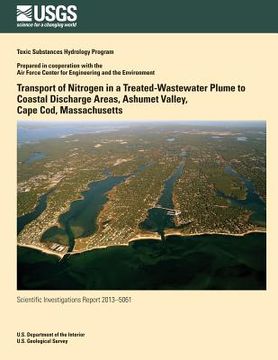Compartir
Transport of Nitrogen in a Treated-Wastewater Plume to Coastal Discharge Areas, Ashumet Valley, Cape Cod, Massachusetts (en Inglés)
Jeffrey R. Barbaro
(Autor)
·
Donald A. Walter
(Autor)
·
Denis R. LeBlanc
(Autor)
·
Createspace Independent Publishing Platform
· Tapa Blanda
Transport of Nitrogen in a Treated-Wastewater Plume to Coastal Discharge Areas, Ashumet Valley, Cape Cod, Massachusetts (en Inglés) - Walter, Donald A. ; LeBlanc, Denis R. ; Barbaro, Jeffrey R.
$ 14.39
$ 17.99
Ahorras: $ 3.60
Elige la lista en la que quieres agregar tu producto o crea una nueva lista
✓ Producto agregado correctamente a la lista de deseos.
Ir a Mis ListasSe enviará desde nuestra bodega entre el
Lunes 10 de Junio y el
Martes 11 de Junio.
Lo recibirás en cualquier lugar de Estados Unidos entre 1 y 3 días hábiles luego del envío.
Reseña del libro "Transport of Nitrogen in a Treated-Wastewater Plume to Coastal Discharge Areas, Ashumet Valley, Cape Cod, Massachusetts (en Inglés)"
Land disposal of treated wastewater from a treatment plant on the Massachusetts Military Reservation in operation from 1936 to 1995 has created a plume of contaminated groundwater that is migrating toward coastal discharge areas in the town of Falmouth, Massachusetts. To develop a better understanding of the potential impact of the treated-wastewater plume on coastal discharge areas, the U.S. Geological Survey, in cooperation with the Air Force Center for Engineering and the Environment, evaluated the fate of nitrogen (N) in the plume. Groundwater samples from two large sampling events in 1994 and 2007 were used to map the size and location of the plume, calculate the masses of nitrate-N and ammonium-N, evaluate changes in mass since cessation of disposal in 1995, and create a gridded dataset suitable for use in nitrogen-transport simulations. In 2007, the treated-wastewater plume was about 1,200 meters (m) wide, 30 m thick, and 7,700 m long and contained approximately 87,000 kilograms (kg) nitrate-N and 31,600 kg total ammonium-N. An analysis of previous studies and data from 1994 and 2007 sampling events suggests that most of biologically reactive nitrogen in the plume in 2007 will be transported to coastal discharge areas as either nitrate or ammonium with relatively little transformation to an environmentally nonreactive end product such as nitrogen gas. Nitrogen-transport simulations were conducted with a previously calibrated regional three-dimensional MODFLOW groundwater flow model. Mass-loaded particle tracking was used to simulate the advective transport of nitrogen to discharge areas (or receptors) along the coast. In the simulations, nonreactive transport (no mass loss in the aquifer) was assumed, providing an upper-end estimate of nitrogen loads to receptors. Simulations indicate that approximately 95 percent of the nitrate-N and 99 percent of the ammonium-N in the wastewater plume will eventually discharge to the Coonamessett River, Backus River, Green Pond, and Bournes River. Approximately 76 percent of the total nitrate-N mass in the plume will discharge to these receptors within 100 years of 2007; 90 and 94 percent will discharge within 200 and 500 years, respectively. Nitrate loads will peak within about 50 years at all of the major receptors. The highest peak loads will occur at the Coonamessett River (450 kg per year (kg/yr) nitrate-N) and the Backus River (350 kg/yr nitrate-N). Because of adsorption, travel times are longer for ammonium than for nitrate; approximately 5 percent of the total ammonium-N mass in the plume will discharge to receptors within 100 years; 46 and 81 percent will discharge within 200 and 500 years, respectively. The simulations indicate that the Coonamessett River will receive the largest cumulative nitrogen mass and the highest rate of discharge (load). Ongoing discharge to Ashumet Pond is relatively minor because most of the wastewater plume mass has already migrated downgradient from the pond.

